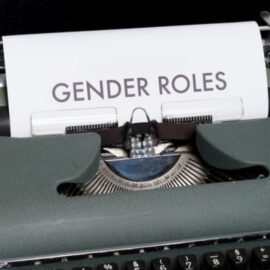

This article gives you a glimpse of what you can learn with Shortform. Shortform has the world’s best guides to 1000+ nonfiction books, plus other resources to help you accelerate your learning.
Want to learn faster and get smarter? Sign up for a free trial here .
Does everyone have trauma from childhood? How can suppressed emotions from your childhood affect your adult relationships?
The source of your suffering may lie hidden in your unconscious, where traumas from your past—and your family’s past—are stopping you from being truly happy and free. Childhood trauma can reverberate throughout your entire life, preventing you from forming healthy relationships in adulthood. Surviving childhood trauma is a lifelong journey, but some deep traumas may never heal fully.
Keep reading to learn about the roots of childhood trauma, how it manifests itself in adulthood, and the steps you can take towards healing.
The Roots of Childhood Trauma
Disrupted parent-child relationships are common. Research shows that 7% to 10% of people in the U.S. have experienced parental rejection—although what qualifies as parental affection and support varies across cultures. Children respond to parental rejection in similar ways regardless of the cultural context—often through disobedience, bullying behaviors, and anxiety. In the long term, trauma manifests in our adult relationships, preventing us from forming romantic relationships and making it difficult to relate to others in healthy ways.
There are two ways children inherit trauma: they internalize it through dysfunctional relationship dynamics and inherit it via biological markers.
Dysfunctional Relationship Dynamics
Children internalize trauma through dysfunctional relationship dynamics in the family and then project that trauma in their adult relationships. Until we unearth and resolve these unhealthy relationship dynamics, we will continue to feel unsettled—and we will continue to unconsciously sabotage our freedom and happiness by projecting trauma from the past onto our current relationships.
There are four common dysfunctional dynamics patterns:
Relationship Dynamic #1: Unconsciously Taking Responsibility for and Repeating a Parent’s Negative Emotions or Trauma
It’s common for us to internalize a parent’s trauma and then project that trauma into our relationships. Here’s an example: If your mom suffers from severe social anxiety while you are growing up, she may isolate herself. In an effort to alleviate her loneliness, you step in as her friend and confidant. Now, as an adult, you are repeating that dynamic with your son while still serving as caretaker for your mother. You resent your mother and feel guilty about imposing on your son.
Relationship Dynamic #2: Renouncing a Parent
Cutting ourselves off from parents who have caused us pain can give us the illusion of freedom, but doing so often blinds us to the ways we embody the very qualities in them we reject. Here’s an example: You cut ties with your father because he had an affair that led to your parents’ divorce. Now the unresolved pain and anger you directed at your father are surfacing in your life in unexpected ways—and you find yourself exhibiting the same qualities you rejected in him. You refuse to consider marriage, you are aloof with your partner who you love deeply, and—to your horror—you find yourself tempted to cheat on him.
Relationship Dynamic #3: Enduring a Disrupted Bond With Our Mother
This disruption may involve your mother’s physical absence (due to work, illness, or travel, for example) or emotional unavailability (perhaps due to intense grief or mental illness). If this break happens while you are young, it can have deep, lasting effects. You might unconsciously avoid getting close to anyone because that feels like a precursor to being hurt or abandoned again.
Relationship Dynamic #4: Repeating the Patterns of a More Distant Relative
We may unconsciously take on behaviors and qualities of family members other than our parents. Here’s an example: You may unconsciously make choices that parallel a disgraced uncle who drank himself out of a high-paying job. You didn’t get fired, but you quit your job without a clear plan, and now you spend your days drinking alone.
Biological Markers
Cellular biologists have demonstrated that environmental influences—including our mother’s behaviors, thoughts, and beliefs—biologically program us to respond to our environment in certain ways.
Just as our mother’s blood nourishes us with oxygen and nutrients while we’re in the womb, she constantly shuttles us hormones and signals generated by her emotions. These hormones and signals shape the chemistry and function of our cells. The cells, in turn, influence which genes get switched on.
Many studies now reveal that children of parents who lived through traumatic events—such as the 9/11 attacks in New York City or the Holocaust during World War II—display gene expression and stress patterns similar to those of their parents, even though they didn’t directly experience the trauma. Control groups confirm the uniqueness of these findings. Although scientists haven’t yet isolated the exact mechanisms responsible for this biological transmission of trauma from parent to child, animal studies indicate that biological markers of trauma can be passed down through at least three generations.
TITLE: It Didn't Start With You
AUTHOR: Mark Wolynn
TIME: 17
READS: 51.3
IMG_URL: https://www.shortform.com/blog/wp-content/uploads/2022/06/it-didn-t-start-with-you-cover.png
BOOK_SUMMARYURL: it-didnt-start-with-you-summary-mark-wolynn
AMZN_ID: XYZ
The Effects of Childhood Trauma
Childhood trauma affects everyone in a unique way. Having said that, there are several commonalities in how childhood trauma manifests both in the short term and in the long term.
The Short-Term Effects of Childhood Trauma
Two of the most common short-term effects of surviving childhood trauma are 1) an inability to love and be loved and 2) an overactive stress response, which can lead to increased anxiety and difficulty concentrating.
1) An Inability to Love and Be Loved
One of the most important skills we develop as infants is the ability to experience love. At this stage of development, we wholly rely on our caregivers to meet our needs (for example, food, soothing, or a diaper change). If caregivers consistently and lovingly respond to our needs and make us feel better, we begin to form positive associations between human contact and comfort. In other words, we learn that being around people and experiencing love makes us feel good.
However, if a child needs something and the caregiver isn’t there, is only there at certain times, or meets the need with an abusive reaction, the child doesn’t associate human contact with comfort and love. Instead, human contact is scary and unpredictable.
This negative view of human contact can hinder the child’s ability to form healthy relationships. Because she doesn’t experience love at home, she might have a harder time giving and receiving it in situations outside the home—for example, at daycare. She might not show affection to her classmates and teachers, or she might not know how to react when someone shows her love.
2) An Overactive Stress Response
Childhood trauma can also overactivate a child’s stress response, making them hypervigilant and anxious. Children who live in an abusive home must always be alert for signs of abuse. This means that their stress responses are very sensitive—more often than not, they’re in a fight-or-flight or dissociative state.
While this overly active stress response helps a child survive at home, in other settings, it isn’t so helpful. A heightened stress response can make it hard for the child to focus in school, make friends, and trust adults. Children who experience trauma are often misdiagnosed with ADHD because they have trouble sitting still and concentrating.
The Long-Term Effects of Childhood Trauma
For children who suffer abuse, trauma’s impact creates long-term issues.The are three broad ways that childhood trauma can impact people in the long-term: 1) mental and physical health issues, 2) flashbacks and triggers, and 3) unrecognized behavioral patterns.
1) Mental and Physical Health Issues
Suffering a traumatic event in childhood increases the risk of a range of mental and physical health issues later in life. People who experienced trauma as children often experience depression and anxiety, as well as physical symptoms such as chronic pain and increased risk of heart disease.
2) Flashbacks and Triggers
Another common long-term effect of trauma is flashbacks, in which a trauma survivor relives a traumatic moment. Flashbacks occur when the brain creates long-lasting associations between the circumstances surrounding a traumatic event and the stress response. For example, if a drunk father hits his child, the child’s brain may create an association between the smell of alcohol and a state of fear. The brain learns that when that smell is present, bad things happen.
For example, when the child grows up, he might suddenly experience a stress response when a middle-aged man smelling of alcohol approaches him. Even if he isn’t in any immediate danger, he might feel suddenly anxious and uneasy. This type of sustained stress response can have negative impacts on our mental and physical health.
3) Unrecognized Behavioral Patterns
Childhood patterns continue to influence us as adults, even though we might not be aware of them. When someone experiences trauma, they come to expect the same patterns of abuse that they suffered as children. This can inhibit our ability to form healthy relationships, especially if we’re unaware of how our childhood trauma is influencing us.
For example, if a person is abandoned by her parents when she’s young, she might later struggle to develop trust in intimate relationships. Because of her childhood trauma, she might mistakenly come to expect that anyone who says they love her will leave. However, if she isn’t aware of her childhood trauma or the effect that it has on her, she might think her feelings are based in reality. This could make it difficult for her to form a trusting relationship.
TITLE: What Happened to You?
AUTHOR: Bruce Perry and Oprah Winfrey
TIME: 17
READS: 33.5
IMG_URL: https://www.shortform.com/blog/wp-content/uploads/2022/07/what-happened-to-you-cover.png
BOOK_SUMMARYURL: what-happened-to-you-summary-bruce-perry-and-oprah-winfrey
AMZN_ID: XYZ
Every Trauma Is Unique
There’s no one-size-fits-all approach to surviving childhood trauma. Every person going through trauma has a different background and different needs.
There are several important pieces of advice for anyone surviving childhood trauma: Lean on your community, ease your stress response in small doses, and have compassion for yourself and others. Let’s explore each strategy in detail:
1) Lean on Your Community
The most important factor in dealing with trauma is experiencing love and support from your community. Even for people without trauma, having meaningful social connections is an excellent indicator of mental health.
However, when surviving childhood trauma, these social connections become even more important. To process traumatic events, survivors need to share their thoughts and feelings with a supportive community. Trauma often makes its victims feel unloved and unworthy. But healthy, communicative relationships can help people feel listened to, cared for, and validated.
Ideally, a therapist can be a part of this community. But not everyone has access to a therapist: A supportive community of family and friends can be just as valuable.
2) Ease Your Stress Response in Small Doses
Trauma creates associations in the brain that can retrigger the stress response even years after the event. When this happens, it becomes difficult or impossible to think rationally. This makes it hard to work through trauma.
Therefore, the first step in working through trauma is to ease your stress response. This retrains the brain’s neural pathways to recognize that it isn’t actually in danger, allowing you to think rationally and process traumatic memories. There are two concrete tips for beginning this process:
1) Use rhythm: Rhythmic activities such as walking, dancing, and coloring can help regulate the body and brain when processing traumatic memories. Rhythmic motions have a therapeutic effect on us, a connection that goes back to the womb, when we hear our mother’s heartbeat and associate it with safety.
2) Address trauma little by little: On a biological level, we can’t think or talk about a traumatic memory for more than a few seconds before our brain tries to protect us and our stress response kicks in. Because of this, it’s best to address trauma in small doses. Thinking about a traumatic memory for only a few seconds (as opposed to forcing yourself to think about it for longer) will make it easier to regulate your stress response.
The need to process trauma bit by bit also helps explain why having a large, healthy, and robust community is so important. According to the authors, having a long conversation with one person won’t be as helpful as having many shorter conversations with different people.
3) Have Compassion for Yourself and Others
Another important element of healing from trauma is having compassion. When a person experiences trauma, they can often feel like something is wrong with them. They might feel that it’s their fault that they can’t sustain a healthy relationship or that seemingly random triggers create anxiety or dissociation. However, having trauma doesn’t mean that something is wrong with you.
Healing Through Images and Rituals
Visualizations and positive experiences—real or imagined—can serve as potent tools for surviving childhood trauma. To understand why this is the case, we must look at how our bodies and brains change over time.
Our bodies and brains are not fixed but rather adapt to our environment and circumstances. When we repeat new, positive experiences—particularly when those experiences feel rewarding and significant—physiological changes start to take place. Our bodies release feel-good hormones and activate genes that improve our stress response. Also, our brains start to form new neural connections, which allows us to experience new, positive thoughts and emotions.
Brain scans confirm that simply imagining a conversation in which we forgive—or an experience that allows us to feel comfort and support—activates the same regions in our brain as if we’re actually living this experience.
Performing healing practices with intention and consistency—and allowing ourselves to be emotionally moved in the process—reprograms our bodies. We replace old, painful images, feelings, and memories with new, positive memories and emotions. Then, when old, unhealthy patterns start to surface, we’ll have a totally new internal reference point—one that will guide us to respond with love, care, and compassion. For example, instead of reacting in anger or shutting down when your mother criticizes you, you will receive her words with grace and true appreciation—knowing that she is loving you in the way she knows.
To sustain these physiological changes and integrate our healing, we must repeat our chosen rituals and visualizations regularly. Ultimately, this will allow us to align our actions with our goals and intentions, opening the door to new possibilities around our health, freedom, and success.
Final Words
Unless we’ve suffered abuse or extreme neglect in our early lives, we may think that we don’t have any psychological trauma. However, nearly everybody has suffered some form of trauma in their childhood. Successfully surviving childhood trauma is about first recognizing how it manifests itself in our relationships and taking small steps towards healing.
Recommended Reading
If you want to learn more about surviving childhood trauma, check out the following books from our library:
Trauma can stem from abuse to a severe car accident to wartime combat—and cause a lifetime of flashbacks, nightmares, isolation, insomnia, hypervigilance, and rage. In The Body Keeps the Score, the author explores how diagnosing and treating trauma has evolved as new technologies, research, and fields of science emerged.
TITLE: The Body Keeps the Score
AUTHOR: Bessel van der Kolk
TIME: 40
READS: 20.7
IMG_URL: https://www.shortform.com/blog/wp-content/uploads/2020/01/body-keeps-score-cover.jpg
BOOK_SUMMARYURL: the-body-keeps-the-score-summary-bessel-van-der-kolk
AMZN_ID: B00G3L1C2K
In Getting the Love You Want, Harville Hendrix and Helen LaKelly Hunt suggest that we unconsciously seek out romantic partners to help us resolve unfinished business from our childhood. When our partners fail to meet our unconscious expectations, our relationships fall apart. To prevent this, Hendrix and Hunt designed a process to change the way couples interact, allowing them to learn about their unconscious needs and to transform their lives into a conscious, loving union.
TITLE: Getting the Love You Want
AUTHOR: Harville Hendrix and Helen LaKelly Hunt
TIME: 17
READS: 20.8
IMG_URL: https://www.shortform.com/blog/wp-content/uploads/2022/07/getting-the-love-you-want-cover.png
BOOK_SUMMARYURL: getting-the-love-you-want-summary-harville-hendrix-and-helen-lakelly-hunt
AMZN_ID: XYZ

Want to fast-track your learning? With Shortform, you’ll gain insights you won't find anywhere else .
Here's what you’ll get when you sign up for Shortform :
- Complicated ideas explained in simple and concise ways
- Smart analysis that connects what you’re reading to other key concepts
- Writing with zero fluff because we know how important your time is






